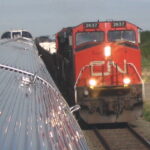First Frequency, now Capacity?
I’ll wager that a year or two from now, an objective analysis will show that what Amtrak is doing with the long-distance trains during this pandemic might possibly have made their bottom line look better, but would also have come at the expense of literally millions of Americans who live in less populated areas outside of the Northeast Corridor. It’s very possible that they will end up with inadequate passenger train service or maybe even none at all.
For instance, the Lake Shore Limited’s schedule has been reduced from 14 trips a week (one departure a day in each direction) to three trains a week in each direction. The Rail Passengers Association registered our objections to this major reduction in frequency. Amtrak ignored us.
But now we understand that Amtrak is also reducing capacity. On at least a few of their long-distance trains some of the sleeping cars have been removed from trains that—let us not forget— are already running on a reduced three-days-a-week schedule.
The Lake Shore Limited continues to be a good example.
The westbound train has two sections—one originates out of New York’s Penn Station with coaches and three sleepers. The other, all coaches, comes from South Station in Boston. They meet in Albany and join there to become one long train en route to Chicago.
Each week before the pandemic, Amtrak had roomettes and bedrooms to sell in 42 sleeping cars (14 trains, each with three sleepers in the consist). After the cut backs, Amtrak has sleeping car space to sell in only 12 sleeping cars: 6 trains, each with two sleepers.
So regarding sleeping car capacity on the Lake Shore Limited, here’s a summary: Six trains a week instead of 14 trains. And an inventory of space in 18 sleeping cars a week instead of 56. And we understand that sleeping cars are being removed from the consists of at least one other long-distance train, the Crescent, that runs between New York City and New Orleans.”
The thing is, no one knows for sure what Amtrak is up to. Are they trying to prove something to the government as they manipulate factors in the temporary mini-systems created while the nation copes with a pandemic?
The very unfortunate fact is that very few of us fully trust Amtrak.
We want to. We need to. But there is a long history that makes trust very difficult. The thing is, this is a critical time when everyone: the railroad, the passengers and the government have to trust each other and work together toward common goals.
These days, that’s a very tall order.




It seems to me that the number of cars would depend directly on ticket sales.
Amtrak claims that ridership is down 85% due to the pandemic. Why would they need to keep running 56 sleeper cars a week, if they are really selling fares for only 15% of that previous capacity (about 8½ cars)? By my calculations, they should run about 12 car-trips per week, because the number of car-trips has to be a multiple of 6 (one car on each of the three trains per week in each direction) to maintain adequate capacity for each and every train, yet at least 8½ to meet the 15% sales. Guess what? That lands you at exactly 12 – the number of cars that they are currently running.
As sales picks up, I figure that it is probably easy enough for Amtrak to add another sleeper car to the consist on a per-run basis, if and when enough sleeper rooms are sold to justify the expense of staffing and operating another sleeper car on a journey halfway across the country and back. Just like it is easy enough to add another coach car, if and when enough coach tickets are sold to fill the capacity of the coach cars already on the rails.
This does not sound like an error in Amtrak management to me, it sounds like good business sense – a reasonable cost reduction plan for keeping the passenger train service alive during a hopefully temporary 85% ridership slump.
Of course, as the federally mandated and state mandated covid restrictions are lifted, and the entire country comes out of the resulting economic slump, it remains to be seen how the clientele ridership will respond. Amtrak might see its equipment capabilities, food quality, and ridership levels returned to healthy and profitable (or nearly so) levels after all.